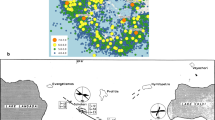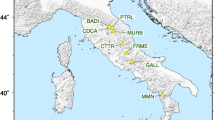Abstract
Time series studies depend mostly on stochastic models for radon seasonal, annual or temporal variability explanations. Others solve radon transport steady state equation analytically to explain radon variability with soil depth. In order to understand radon variability comprehensively, there is the need for a model which encapsulates most required information about its seasonal variability from different aspects. In this paper, soil radon time series is modeled on the North Anatolian Fault Zone in Turkiye. The general PDE representing radon soil dynamics and boundary conditions is employed successfully through a hybrid regression model, which captures and forecasts radon seasonal anomaly as well as its depth profile. An efficient model can be used to estimate other radon-related variables like diffusion rate and velocity. The model evaluation criteria facilitated the forecast of almost 86% variation of radon concentration with an RMSE value of 9.4 Bqm−3, which is reasonable considering the nature of data used. This model is simple and can provide a realistic statistical outcome on any radon data. The relationship between Rn and soil temperature was also investigated. Radon seasonal anomaly is observed to attain its maximum and minimum values in summer and winter seasons. A solid correlation is obtained between radon and soil temperature at various depths. The radon anomaly in normal conditions is found to correlate strongly with the model. Monte Carlo simulation procedure is affected by taking the mean of 300 simulation paths within \(\pm \,2\sigma\) from the regression curve with practically acceptable results.







Similar content being viewed by others
References
Almayahi BA, Tajuddin AA, Jaafar MS (2013) In situ soil 222Rn and 220Rn and their relationship with meteorological parameters in tropical Northern Peninsular Malaysia. Radiat Phys Chem 90:11–20
Ambraseys NN (1970) Some characteristic features of the Anatolian fault zone. Tectonophysics 9(2–3):143–165
Antonopoulos-Domis M, Xanthos S, Clouvas A, Alifrangis D (2009) Experimental and theoretical study of radon distribution in soil. Health Phys 97(4):322–331
Al-Zoughool M, Krewski D (2009) Health effects of radon: a review of the literature. Int J Radiat Biol 85(1):57–69
Baskaran, M. (2016). Radon in groundwater system. In: Radon: a tracer for geological, geophysical and geochemical studies. Springer, Cham, pp 167–188
Barman C, Ghose D, Sinha B, Deb A (2016) Detection of earthquake induced radon precursors by Hilbert Huang Transform. J Appl Geophys 133:123–131
Blomberg AJ et al (2019) Effect modification of ambient particle mortality by radon: a time series analysis in 108 U.S. cities. J Air Waste Manag As 69(3):266–276
Barkat A et al (2018) Time series analysis of soil radon in Northern Pakistan: implications for earthquake forecasting. Appl Geochemistry 97:197–208
Citation-Curve fitting toolbox : for use with MATLAB® : user’s guide - UW-Madison Libraries.” [Online]. Available: https://search.library.wisc.edu/catalog/999937614302121/cite. Accessed 18 Jul 2020
Dmitriev EM (2018) Influence of atmospheric radon transport on a radon flux from the surface. Izv Phys Solid Earth 54(5):775–781
Dobrovolsky IP, Zubkov SI, Miachkin VI (1979) Estimation of the size of earthquake preparation zones. Pure Appl Geophys Pageoph 117(5):1025–1044
Equinox and solstice time for resadiye–timehubzone․com. [Online]. Available: https://www.timehubzone.com/seasons/turkey/resadiye?year=2001&hours=12. Accessed: 23 Oct 2019
Fleischer RL (1981) Dislocation model for radon response to distant earthquakes. Geophys Res Lett 8(5):477–480
Ghosh D, Deb A, Sengupta R, Patra KK, Bera S (2007) Pronounced soil-radon anomaly-precursor of recent earthquakes in India. Radiat Meas 42(3):466–471
Ghosh A, Vidale JE, Peng Z, Creager KC, Houston H (2009) Complex nonvolcanic tremor near Parkfield, California, triggered by the great 2004 Sumatra earthquake. J Geophys Res Solid Earth 114(12):1–12
Hayashi K et al (2015) Normal seasonal variations for atmospheric radon concentration: a sinusoidal model. J Environ Radioact 139:149–153
Hubert-Ferrari A et al (2000) Seismic hazard in the Marmara sea region following the 17 august 1999 Izmit earthquake. Nature 404(6775):269–273
HubertFerrari A, Armijo R, King G, Meyer B, Barka A (2002) Morphology, displacement, and slip rates along the North Anatolian Fault Turkey. J Geophys Res Solid Earth 107(B10):ETG 9-1–ETG 9-33
Iakovleva VS, Ryzhakova NK (2003a) A method for estimating the convective radon transport velocity in soils. Radiat Meas 36(1–6):389–391
Iakovleva VS, Ryzhakova NK (2003b) Spatial and temporal variations of radon concentration in soil air. Radiat Meas 36(1–6):385–388
Jeon S, Hong B (2016) Monte Carlo simulation-based traffic speed forecasting using historical big data. Futur Gener Comput Syst 65:182–195
Jönsson G (1995) Radon gas—where from and what to do? Radiat Meas 25(1–4):537–546
Kamra L (2015) Seasonal emanation of radon at Ghuttu, northwest Himalaya: differentiation of atmospheric temperature and pressure influences. Appl Radiat Isot 105:170–175
King CY (1978) Radon emanation on San Andreas Fault. Nature 271(5645):516–519
Kikaj D, Jeran Z, Bahtijari M, Stegnar P (2016) Radon in soil gas in Kosovo. J Environ Radioact 164:245–252
Kobayashi Y et al (2015) Annual variation in the atmospheric radon concentration in Japan. J Environ Radioact 146:110–118
Külahcı F, Şen Z, Kazanç S (2008) Cesium concentration spatial distribution modeling by point cumulative semivariogram. Water Air Soil Pollut 195(1–4):151–160
Külahcı F, Şen Z (2014) On the correction of spatial and statistical uncertainties in systematic measurements of 222Rn for earthquake prediction. Surv Geophys 35(2):449–478
Külahcı F, Çiçek Ş (2015) Time-series analysis of water and soil radon anomalies to identify micro–macro-earthquakes. Arab J Geosci 8(7):5239–5246
Kumar A, Singh S, Mahajan S, Bajwa BS, Kalia R, Dhar S (2009) Earthquake precursory studies in Kangra valley of North West Himalayas, India, with special emphasis on radon emission. Appl Radiat Isot 67(10):1904–1911
Lewis-beck MS, Skalaban A (1990) The R-squared: Some straight talk. Polit Anal 2(1):153–171
Mitev K, Dutsov C, Georgiev S, Boshkova T, Pressyanov D (2019) Unperturbed, high spatial resolution measurement of Radon-222 in soil-gas depth profile. J Environ Radioact 196:253–258
Mentes G, Eper-Pápai I (2015) Investigation of temperature and barometric pressure variation effects on radon concentration in the Sopronbánfalva Geodynamic Observatory, Hungary. J Environ Radioact 149:64–72
Mehta N, Kocar B (2018) Deciphering and predicting microscale controls on radon production in soils, sediments and rock. Soil Syst 2(2):30
Murtha JA (1993) Incorporating historical data in Monte Carlo simulation. Proc - Pet Comput Conf 6(April):193–200
Nazaroff WW (1992) Radon transport from soil to air. Rev Geophys 30(2):137–160
Orabi M (2018) Multi-layer description model for radon concentration in soil. Eur Phys J Plus 133(4):135
Omori Y et al (2007) Anomalous radon emanation linked to preseismic electromagnetic phenomena. Nat Hazards Earth Syst Sci 7(5):629–635
Ongori JN, Lindsay R, Mvelase MJ (2015) Radon transfer velocity at the water–air interface. Appl Radiat Isot 105:144–149
Papachristodoulou C, Stamoulis K, Ioannides K (2020) temporal variation of soil gas radon associated with seismic activity: a case study in NW Greece. Pure Appl Geophys 177(2):821–836
Peña AM (2011) Radioactive air sampling methods. Health Phys 101(6):761
Parmar KS, Bhardwaj R (2014) Water quality management using statistical analysis and time-series prediction model. Appl Water Sci 4(4):425–434
Pulinets SA, Alekseev VA, Legen’ka AD, Khegai VV (1997) Radon and metallic aerosols emanation before strong earthquakes and their role in atmosphere and ionosphere modification. Adv Sp Res 20(11):2173–2176
Riley WJ, Robinson AL, Gadgil AJ, Nazaroff WW (1999) Effects of variable wind speed and direction on radon transport from soil into buildings: model development and exploratory results. Atmos Environ 33(14):2157–2168
Riggio A, Santulin M (2015) Earthquake forecasting: a review of radon as seismic precursor. Boll Di Geofis Teor Ed Appl 56(2):95–114
Singh S, Jaishi HP, Tiwari RP, Tiwari RC (2017) Time series analysis of soil radon data using multiple linear regression and artificial neural network in seismic precursory studies. Pure Appl Geophys 174(7):2793–2802
Samet JM (1989) Review: radon and lung cancer. JNCI 89(10):745–758
Şen Z (2009) Spatial modeling principles in earth sciences. Springer, Berlin
Siino M, Scudero S, Cannelli V, Piersanti A, D’Alessandro A (2019) Multiple seasonality in soil radon time series. Sci Rep 9(1):1–13
Steinskog DJ, Tjøtheim DB, Kvamstø NG (2007) A cautionary note on the use of the Kolmogorov–Smirnov test for normality. Mon Weather Rev 135(3):1151–1157
Sawilowsky SS, Blair RC (1992) A more realistic look at the robustness and Type II error properties of the t test to departures from population normality. Psychol Bull 111(2):352–360
Schubert M, Schulz H (2002) Diurnal radon variations in the upper soil layers and at the soil-air interface related to meteorological parameters. Health Phys 83(1):91–96
Silver PG, Wakita H (1996) A search for earthquake precursors. Science 273(5271):77–78
Talwani P, Moore WS, Chiang J (1980) Radon anomalies and microearthquakes at Lake Jocassee, South Carolina. J Geophys Res 85(B6):3079–3088
Tsunomori F, Kuo T (2010) A mechanism for radon decline prior to the 1978 Izu-Oshima-Kinkai earthquake in Japan. Radiat Meas 45(1):139–142
Viñas R, Eff-Darwich A, Soler V, Martín-Luis MC, Quesada ML, de la Nuez J (2007) Processing of radon time series in underground environments: Implications for volcanic surveillance in the island of Tenerife, Canary Islands, Spain. Radiat Meas 42(1):101–115
Várhegyi A, Somlai J, Sas Z (2013) Radon migration model for covering U mine and ore processing tailings. Rom Rep Phys 58:298–310
Wilcox RR (1997) Some practical reasons for reconsidering the Kolmogorov-Smirnov test. Br J Math Stat Psychol 50(1):9–20
Yap BW, Sim CH (2011) Comparisons of various types of normality tests. J Stat Comput Simul, vol 9655, ISSN0094-9655
Yang J, Busen H, Scherb H, Hürkamp K, Guo Q, Tschiersch J (2019) Modeling of radon exhalation from soil influenced by environmental parameters. Sci Total Environ 656:1304–1311
Yücel B, Özgür R (1992) Geology and geothermal energy possibilities of reşadiye (Tokat) region, Department of energy raw material survey and exploration, Report No 10466, Mineral Research and Exploration Directorate (in Turkish)
Acknowledgements
We would like to thank AFAD-Ministry of Interior Disaster and Emergency Management Presidency for the radon data (https://en.afad.gov.tr/). This research covers some of Ahmad Muhammad and Pistiwan Akram's doctoral thesis research. We would like to thank Fırat University for their support. Finally, we would also like to thank Thomas Glade (Editor in Chief) for his approach to developing this article and managing the editorial process, and to both referees for their constructive and encouraging criticism.
Author information
Authors and Affiliations
Corresponding author
Additional information
Publisher's Note
Springer Nature remains neutral with regard to jurisdictional claims in published maps and institutional affiliations.
Rights and permissions
About this article
Cite this article
Muhammad, A., Külahcı, F. & Akram, P. Modeling radon time series on the North Anatolian Fault Zone, Turkiye: Fourier transforms and Monte Carlo simulations. Nat Hazards 104, 979–996 (2020). https://doi.org/10.1007/s11069-020-04200-8
Received:
Accepted:
Published:
Issue Date:
DOI: https://doi.org/10.1007/s11069-020-04200-8




